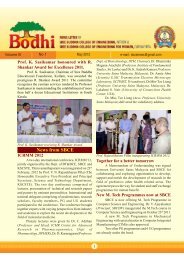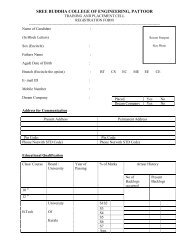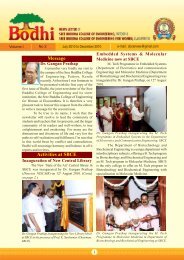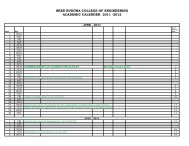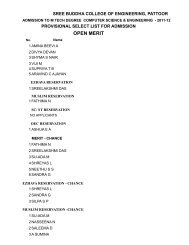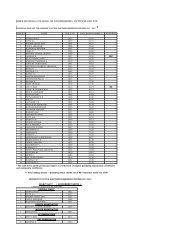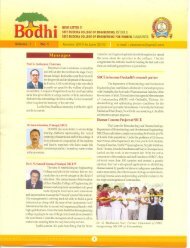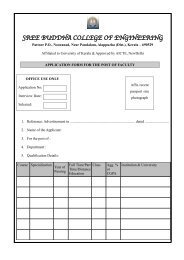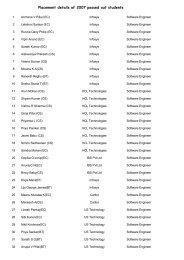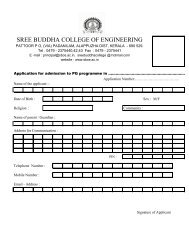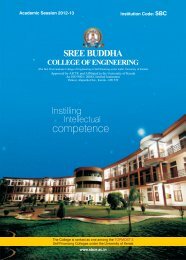UNIVERSITY OF KERALA
UNIVERSITY OF KERALA
UNIVERSITY OF KERALA
Create successful ePaper yourself
Turn your PDF publications into a flip-book with our unique Google optimized e-Paper software.
08.405 INDUSTRIAL BIOPROCESS TECHNOLOGY (B)<br />
Credits: 04 L/T/P: 3/1/0<br />
MODULE I<br />
A historical overview of industrial fermentation process – traditional and modern biotechnology. A brief survey of<br />
organisms, processes, products relating to modern biotechnology-industrially useful microorganisms. Process flow<br />
sheeting – block diagrams with industrial pictorial representation for various equipments.<br />
Raw materials for fermentation process: Isolation, preservation and improvement of industrial micro-organisms for<br />
overproduction of primary and secondary metabolites. Medium requirements for fermentation process carbon, nitrogen,<br />
minerals, vitamins and other nutrients. Examples of simple and complex media. Basic design of the fermenter,<br />
overview of fermentation processes.<br />
Production and purification of primary metabolites : Industrial processes for the manufacture with the important<br />
engineering problems involved in the manufacture of the following products with flow diagram, reactions and<br />
conditions:-<br />
Organic acids-citric acid, lactic acid itaconic acid and acetic acid and other commercially important organic acids;<br />
amino acids -glutamic acid, lysine, phenyalanine, aspartic acid and other commercially important amino acids;<br />
alcohols:- ethanol, acetone and butanol.<br />
MODULE II<br />
Production of secondary metabolites :- Industrial production processes for various classes of secondary metabolites:<br />
antibiotics: beta-lactams-penicillin and cephalosporin; aminoglycosides- streptomycin, kanamycin; macrolideserythromycin,<br />
quinines, aromatics; commercially important vitamins and steroids.<br />
Production and purification of enzymes and other byproducts: Microbial production of industrial enzymes: proteases,<br />
amylases, lipases and cellulases. Production of biofertilizers- manufacture, formulation and utilization, biopesticides:-<br />
Characteristics of biopesticides. Important biopesticides- Bt-toxin, Kasugamycin, Beauverin, Devine and Collego.<br />
Biopreservatives- Nisin; biopolymers- Xanthan gum and PHB; single cell protein.<br />
Beverages:- production of beverages, beer, wine, microbes in baking- production of baker’s yeast, milk products.<br />
Bioremediation- microbes in mining, ore leaching, oil recovery, waste water treatment, biodegradation of non cellulose<br />
and cellulosic wastes for environmental conservation<br />
MODULE III<br />
Production modern biotechnology products: Production of recombinant proteins having therapeutic and diagnostic<br />
applications, production of vaccines. Production of monoclonal antibodies. Products of plant and animal cell culture.<br />
Enzymes: Isolation and purification of commercially important enzymes: Extraction of enzymes, preparation of crude<br />
enzymes, purification and characterization of enzymes from plant, animal and microbial sources. Application of enzymes in<br />
industry, analytical purposes and medical therapy.<br />
REFERENCES<br />
1. Casida Jr, L.E, Industrial Microbioloy, New Age International (P) Ltd.<br />
2. Presscott, Dunn, Industrial Microbiology, Agrobios (India).<br />
3. Wulf Cruger and Anneliese Crueger, Biotechnology: A Textbook of Industrial Microbiology, Panima<br />
Publishing Corporation.<br />
4. Murrey Moo and Young, Comprehensive Biotechnology, Pergamon.<br />
5. Palmer T, Enzymes: Biochemistry, Biotechnology, Clinical chemistry, Horwood publishing Colphon.<br />
6. Jackson, A.T, Process engineering in biotechnology, Prentice Hall.<br />
The question paper consists of Part A and Part B. Part A is for 40 marks. Part A consists of 10 compulsory short<br />
answer questions each carrying 4 marks covering the entire syllabus.<br />
Part B is for 60 marks. There will be two questions from each module. The candidate has to answer one question of 20<br />
marks from each module.<br />
No charts, tables, codes are permitted in the Examination hall if necessary relevant data is given along with the<br />
question paper by the question paper setter.<br />
32



